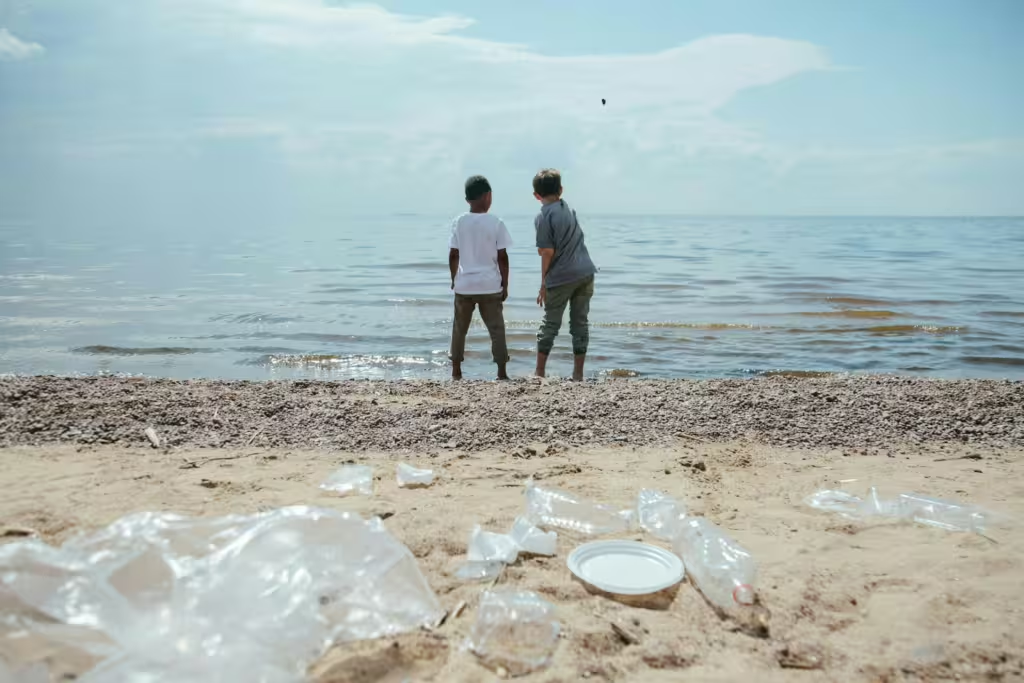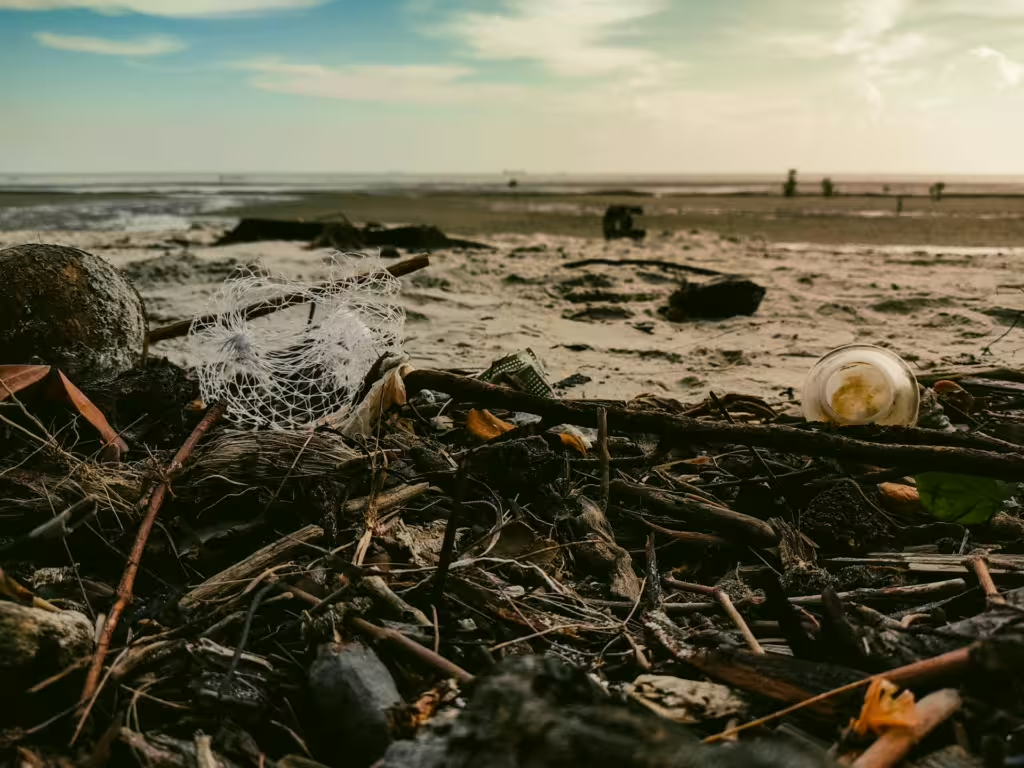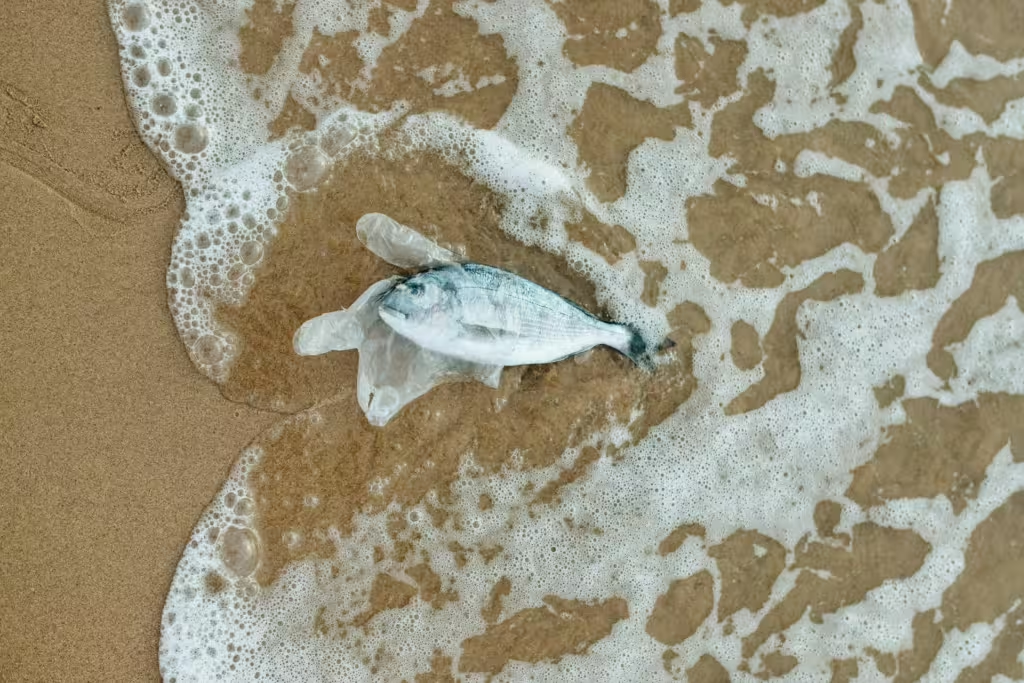The world’s oceans cover over 70% of Earth’s surface. This vast ecosystem, or series of ecosystems, more specifically, are vital to our planet’s health…and they are in grave peril. Between chemical dumping, plastic pollution, climate change, and a host of other serious, human-driven problems, the soon-to-be future generations of our species are about to have a rather big problem on their hands.
The oceans act as a means of regulating the climate, acting as a carbon sink, absorbing around one-quarter of the carbon dioxide produced by human activities, which helps to moderate global warming. They provide food for billions of organisms, including humans, and support a vast array of biodiversity. What many folks don’t realize is that they also generate more than half of the world’s oxygen through the photosynthetic activity of microscopic organisms like phytoplankton. Beyond their environmental importance, oceans play a critical role in the global economy, supporting a multitude of industries such as fisheries, tourism, and shipping. Coral reefs and mangroves, both of which are also in peril in their own right, provide natural coastal protection by absorbing wave energy, which reduces the impact of storms and erosion.
In this article, we’ll explore the ocean’s many ecological benefits and its vital role in supporting life on Earth. We will also talk about the many issues that we, as humans, have caused as a result of our hubris, overreaching, consumption, and wasteful natures. Finally, we will try to suss out some ways that we can fix the problems and bring the planet back to some sort of oceanic homeostasis…if indeed that is possible at this late stage.
Human Problems, Human Solutions
Despite their immense value and the countless lives that depend on their continued health and survival, marine environments are under severe threat from humankind. Overfishing, habitat destruction, and most alarmingly, pollution are degrading ocean health at an unprecedented rate; and that rate is accelerating with each passing year. From floating plastic debris to invisible microscopic particles and chemical contaminants, pollutants infiltrate every level of marine food chain and insinuate themselves into all marine ecosystems. The thing is, these threats don’t just impact marine species but also the millions of people who rely on the oceans for their livelihoods and food security.
Thus, the unending degradation of marine habitats is a threat to us all. Moreover, it also weakens their ability to perform essential functions, such as carbon sequestration and nutrient cycling; both of which we need in place to fix other environmental crises of our own design! Ultimately, our only course of action is to protect the oceans in any ways that we can. However, protecting the oceans requires global cooperation, sustainable practices, and a stronger commitment to reducing pollution at its source; all of which are a heck of a lot harder than they sound.
Marine Pollution In All Its Forms
When we talk about marine pollution, we aren’t just discussing oil spills or the Great Pacific Garbage Patch; though that last one certainly bears some discussion down the line. No, when we discuss pollution, we are talking about the all encompassing introduction of harmful substances into the ocean, the result of which are detrimental effects on marine organisms and habitats for years and decades to come. This pollution is a human problem and it originates from various human-derived sources, including land-based activities and maritime operations.
The most common pollutants found in ocean waters include plastics, chemicals, oil, heavy metals, and excess nutrients, all of which have shown an insidious capacity to alter marine ecosystems in profound and terrible ways. What most people don’t know is that land-based sources, such as agricultural runoff and untreated sewage, account for approximately 80% of marine pollution. These pollutants are carried by rivers and stormwater systems directly into coastal waters, often without any filtration or treatment.
Also. marine pollution doesn’t just affect water quality—it has far-reaching consequences for biodiversity and human health. Contaminated seafood, the worry you always hear about in regards to “high levels of mercury” and the like, are just a few examples of the risks that oceanic pollution poses poses to consumers. At the same time, polluted beaches and coastal waters are already deterring tourism and reducing property values along coastlines the world over.
Vital marine ecosystems, such as coral reefs, have already proven quite vulnerable to climate change, and ocean pollution is just another dangerous element that threatens their continued survival. Corals themselves are particularly sensitive to pollution and can take decades to recover once they have become damaged. Moreover, pollutants often interact with each other, creating cumulative or even synergistic effects that amplify their impact on marine lifeforms.
The solutions are few and difficult to achieve. Indeed, addressing marine pollution requires a multifaceted approach that involves global cooperation; something that seems almost impossible in this particular day and age. Nevertheless, stricter regulations, public awareness campaigns with wider reach and appeal, technological innovations, and international collaboration are vital to providing some relief to our beleaguered oceans. In the end, it is only by understanding the sources and effects of marine pollution, can we take informed actions to preserve the health and sustainability of our oceans for future generations. This is why we have written this article today and why it is so imperative that you read on.
Types of Marine Pollution and Their Impacts

Plastic Pollution
Of all the pervasive pollutants in the ocean, plastic is probably one of the most recognizable. Whether seen or unseen, plastic makes up a gigantic portion of pollution in ecosystems all over the world. Each year, millions of tons of plastic enter the oceans, where it floats, sinks, is ingested, or breaks down over the course of centuries. can persist for centuries.
Despite its likely unappealing taste profile, many marine animals will mistake plastic debris for food, leading to accidental ingestion that can cause internal injuries, starvation, and death. Animals can also become entangled in plastic waste, leading to drowning or severe, life-threatening injuries. Then there are the microplastics, tiny plastic particles that represent the end-result of plastic breakdown over time. These insidious particles have been found in various marine organisms, indicating widespread contamination of the food chain.
Even human beings are not immune to the presence of microplastics, which, in addition to being potentially cancer-causing, can also absorb and transport toxic other chemicals, making them even more hazardous when ingested or integrated into our bloodstream. Beyond harming wildlife and human health, plastic pollution affects tourism and fishing industries. In coastal areas, plastic waste clogs waterways and spoils an areas natural beauty.
Despite all this, efforts to address plastic pollution are in effect. These efforts include international agreements, local clean-up initiatives, bans on single-use plastics, and the development of biodegradable alternatives. That said, reducing plastic production and promoting recycling are crucial to enacting long-term solutions.
Chemical Pollution
Industrial discharges, agricultural runoff, and sewage are all examples of harmful chemical pollutants that find their way into the oceans. These pollutants aren’t just harmful on their own but tend to have heavy metals, pesticides, and nutrients like nitrogen and phosphorus in them. Those aforementioned elements can be exceptionally harmful for marine creatures and humans who like to eat them now and then.
You might think that excess nutrients like nitrogen are a good thing, but anything in excess can be harmful. Those nutrients, for example, can lead to eutrophication, causing algal blooms that deplete oxygen in the water and create “dead zones” where most forms of marine life cannot survive. Chemical contaminants can also accumulate in the tissues of marine organisms, leading to a host of reproductive issues and increased mortality rates through many different animal types. Some chemicals, such as PCBs and DDT, may even persist in the environment for decades. Those same chemicals are known to disrupt hormone systems in wildlife and who knows if humans are affected.
In addition, sediment-bound chemicals can affect the benthic (bottom-dwelling) organisms that form the base of the marine food web. These chemicals generally spring from runoff in urban areas and industrial zones. This means that making regulation and monitoring is more essential than ever, though implementing better waste management systems and encouraging sustainable agricultural practices will need to be amped-up in order to make a difference.
Oil Spills
We’ve all seen the news coverage of oil spills. We have seen how destructive they can be, how many thousands of animals perish in the aftermath. Therefore, unlike some other pollutants, many of us have seen firsthand how oil spills, whether resulting from accidents or illegal discharges, can have devastating effects on marine habitats. Oil coats the bodies of marine animals, impairing their ability to move, breathe, and maintain their body temperature. When it spills, it also contaminates shorelines and sensitive habitats like mangroves and coral reefs, leading to long-term ecological damage that cannot be easily undone.
This is due to several factors and most of them have to do with cleanup efforts. These efforts can costly, time-consuming, and are often left incomplete, leaving lasting impacts on local economies and ecosystems. The toxic components of oil, such as polycyclic aromatic hydrocarbons (PAHs), have been proven to poison marine life and persist in sediments for many years thereafter. Marine birds and mammals exposed to oil have been witnessed suffering from hypothermia, organ damage, and impaired reproduction.
Then there are the nearby coral reefs, which are already vulnerable to climate change, plastics, and chemicals. Corals can be further stressed or outright destroyed by oil exposure. In the end, preventing oil spills through improved ship safety, stricter regulations, and rapid-response contingency planning are the only surefire ways to protect marine environments, though many corners are cut in deference to profits.
Thermal Pollution
Discharges of heated water from industrial processes can raise the temperature of marine environments, affecting marine species in several ways. These rising temperatures can affect the metabolism and reproduction of aquatic organisms, while simultaneously exacerbating the effects of climate change, leading to coral bleaching and altered species distributions. Additionally, warmer waters hold less dissolved oxygen, further stressing marine life and contributing to hypoxia; a condition that can eliminate huge swaths of underwater life. Reducing thermal pollution is yet another vital element towards preserving aquatic biodiversity and keeping these marine ecosystems stable and healthy.
Consequences for Marine Habitats
Coral Reefs
Coral reefs are highly sensitive to pollution, climate change, and basically anything that disrupts their delicate niche they occupy in the marine ecosystem. This is particularly problematic, simply because they are such a vital part of marine life. Chemical contaminants and increased nutrient levels can lead to algal overgrowth, smothering corals and reducing light availability, while pollution-induced stress makes corals more susceptible to bleaching and disease. Many creatures depend on these ecosystems, including humans, so this is a serious problem that has yet to be solved.
Seagrass Beds
Seagrass meadows are vital for carbon sequestration, which helps to mitigate the effects of climate change. They also serve as nurseries for many marine species. However, these forests are dwindling almost as much as terrestrial rainforests, declining due to pollution from sewage and agricultural runoff. These pollutants introduce excessive nutrients and sediments, hindering the seagrass beds and kelp forests’ growth and survival.
Mangrove Forests
Mangroves protect coastlines and provide habitat for diverse marine life but pollution from oil spills and heavy metals can damage these forests. When they are so-damaged, it reduces their ability to support biodiversity and protect against erosion.
Open Ocean and Deep Sea

Even remote ocean areas are not immune to the effects of pollution. Plastic debris accumulates in ocean gyres, forming massive garbage patches (like the Great Pacific One) that harm marine life. Microplastics are just as dangerous and insidious and have been found in deep-sea organisms, indicating the far-reaching impact of marine pollution.

True Investigator Says…
As you can see, marine pollution is a multifaceted problem that requires comprehensive and collaborative solutions from organizations and individuals all over the world. Remember, protecting marine habitats is not only essential for the health of the oceans but also for the continued well-being of human societies on nearly every continent. We all depend on the oceans for food, oxygen, and for life. In the end, it will only be through concerted efforts in policy, technology, education, and restoration, that we can work together towards a cleaner and more sustainable future for all living things.
Discover more from TrueInvestigator
Subscribe to get the latest posts sent to your email.


